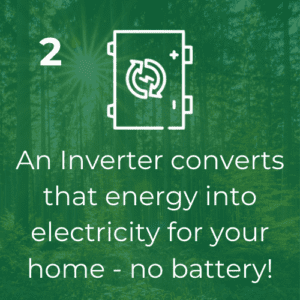How we prepare quotes

First we need to look at how many Kilowatt Hours of electricity you use every year.
If your annual usage isn’t available on your electricity bill, you can find it by accessing your utility provider’s online portal.

We’ll analyze your property to determine the most productive and efficient design options.

We’ll prepare a detailed quote and custom design for your property. This will include several design options so you can choose the best fit.

We finalize the estimate by measuring sunlight and calculating shading at your property to provide a highly accurate estimate of how much power you’ll produce every year.
Solar technologies have become very advanced. Even if your roof slopes East or West and has several trees, there may still be good solar potential. Let our Design Experts show you what’s possible at your property.
Grid-Tied Solar
Grid-tied solar allows you to generate clean, renewable energy while maintaining a reliable connection to the grid. Your panels generate direct current electricity which is converted by micro-inverters into the alternating current used in your home and compatible with the grid.
When your solar panels are generating energy, your building uses this electricity first. If you generate more than you need, it flows into the grid for others to use, using a bi-directional meter to track your credits.
This technology is a major contributor to a more resilient and decentralized energy infrastructure.
Net-Metering / Micro-Generation




Micro-Inverters
Micro-inverter technology offers exponentially enhanced energy harvest and reliability over the previous generation of string inverters, which are connected in series so that the performance of the entire array is affected by shading on a single panel without additional expensive hardware.
By contrast, Micro-inverters are installed on each pair of panels and optimize the performance of every panel independently, ensuring the best power production. Any shading of one unit has minimal impact on the overall system. They also do not require any new hardware near your electrical panel as they are connected by trunk cables and traditional breakers in your panel.

Monitoring APP
With the APsystems Electricity Monitoring App, you can watch real-time solar data right on your phone. You can see energy production for the entire array as well as by individual panel, showing you output by day, month, and year. It also calculates energy cost savings and CO2 reduction. (Your array must be in wifi range for to send data to the app).



Batteries
Grid-tied solar arrays with small Battery Back-up Systems, which ensure some power availability during an outage on the grid, can be ideal for a property’s needs.
It’s important to note that the cost of battery systems can outweigh the cost of a solar array, so in many cases the financial equation is greatly affected. Typical Battery Backup Systems designed to provide roughly 36 hours of emergency storage tend to start around $20,000.
Hard-wiring a generator into your home is a popular alternative, depending on your requirements. This can also be tied into a battery system as a secondary backup.
If you have a home or property that is not tied to or near the grid, off-grid arrays with battery storage are possible in a huge variety of sizes and configurations. Talk to us to look at your options.
Snow
Your solar panels will continue to produce energy, with lower efficiency, with a light snow cover. Any more may stop them producing entirely, although they tend to shed snow well when the sun is out.
The important thing to keep in mind is that winter months are the least productive time for solar due to the sun’s low angle and the shortness of the day. Looking at the annualized picture of your solar energy production, losses in the snowy months are insignificant to the total.

